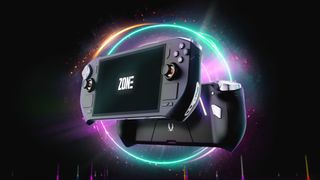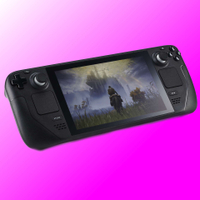Zotac Gaming officially launches its Zone handheld gaming PC with a super fancy AMOLED HDR screen
But the handheld party is already pretty full, so will a (very) late entrance make much of an impact?

All of us in the PC Gamer Hardware tower-of-tech love a good handheld gaming PC. Whether it's the luscious screen and brilliant software ecosystem of the OLED Steam Deck or the raw power of the ROG Ally X, the market is awash with all kinds of devices. And now Zotac, purveyor of GeForce RTX graphics cards and mini PCs, is throwing its gauntlet into the ring with its Zone handheld, replete with a 7-inch AMOLED screen.
The display is probably the biggest selling feature of the Zotac Gaming Zone and we first laid our eyes (and sticky mitts) on it back in January, at the annual Computex event. In terms of size, resolution, and refresh rate, it's par course for the market (7 inches, 1080p, 120 Hz) but it uses an AMOLED touch-sensitive panel, with a claimed colour gamut of more than 100% DCI-P3 and 150% sRGB.
With a peak brightness of 800 nits, it should be ideal for gaming outdoors, although it's not clear what that will drop to when it's displaying HDR content. According to fellow staff Chris, "...in a brightly lit environment, [it] really impressed with the brightness, contrast, and color reproduction."
Zotac has also given the Zone (or how about ZGZ, for short?) a decent set of control options, with dual Hall Effect thumbsticks and two-stage adjustable triggers, radial dials around the sticks, two trackpads, plus two buttons around the back. Of course, we don't know how well these all work until we get our hands on a ZGZ and properly test it, but there's no shortage of control options, at least.
The rest of the hardware is fairly standard fare for a modern handheld gaming PC—an AMD Ryzen 7 8840U, with 8 CPU cores, 16 threads, and 768 RDNA 3 shaders that handle all the gaming duties. That gets backed up with 16 GB of LPDDR5-7500 RAM, which is nice and fast, but having spent a lot of time using the ROG Ally X with its 24 GB of RAM, I think 16 GB is perhaps a little lacking.



It's a similar story for the storage, as it's just 512 GB. Given the size of many games these days, that's really not enough, though the Zone does use a standard PCIe 4.0 M.2 2280 interface which should make it easy enough to expand the capacity with a speedy gaming SSD.
But you do get a built-in kickstand, WiFi 6E and Bluetooth 5.2 wireless connectivity, a UHS-II microSD slot, and two USB4 ports for handling external displays and peripherals. There's even a fingerprint scanner and a 720p front-facing camera, so it's not short on the extra goodies. Zotac also makes a dedicated dock and carry case.
The biggest gaming news, reviews and hardware deals
Keep up to date with the most important stories and the best deals, as picked by the PC Gamer team.
Weighing in at 692 g (1.53 lbs), I expected the Zone to have a large battery but it's only rated to 43 Wh. That was acceptable a year or two ago but with the ROG Ally X sporting an 80 Wh battery with a similar weight, I do think Zotac has missed a trick here.
As with all handheld gaming PCs, the specifications only tell you half a story. How it feels in one's hands, how thermals and noise are managed, and the software ecosystem play a really important role in how enjoyable such devices are. If we get a Zotac Gaming Zone in for review, we'll be sure to let you know.
Best handheld gaming PC: What's the best travel buddy?
Steam Deck OLED review: Our verdict on Valve's handheld.
Best Steam Deck accessories: Get decked out.

Nick, gaming, and computers all first met in 1981, with the love affair starting on a Sinclair ZX81 in kit form and a book on ZX Basic. He ended up becoming a physics and IT teacher, but by the late 1990s decided it was time to cut his teeth writing for a long defunct UK tech site. He went on to do the same at Madonion, helping to write the help files for 3DMark and PCMark. After a short stint working at Beyond3D.com, Nick joined Futuremark (MadOnion rebranded) full-time, as editor-in-chief for its gaming and hardware section, YouGamers. After the site shutdown, he became an engineering and computing lecturer for many years, but missed the writing bug. Cue four years at TechSpot.com and over 100 long articles on anything and everything. He freely admits to being far too obsessed with GPUs and open world grindy RPGs, but who isn't these days?
Most Popular







